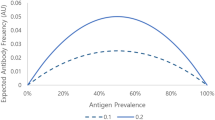Abstract
FOLLOWING the report of McGinnis et al. that the red cells of fifteen out of forty patients with leukaemia tested by them had a diminution of I antigen1, we tested red cells from fifteen patients with acute leukaemia using anti-I sera from the following three persons: (a) a group A patient with M. pneumoniae infection whose serum was obtained at the time of a transient rise of her cold agglutinin titre to 128 at 4° C; (b) a group A patient with the chronic cold agglutinin syndrome who had a cold agglutinin titre of 1,024 at 4° C; and (c) a healthy donor of group Ai who had a cold agglutinin titre of 8 at 4° C. These sera were used after neutralization of isoagglutinin anti-B with group B substance.
This is a preview of subscription content, access via your institution
Access options
Subscribe to this journal
Receive 51 print issues and online access
$199.00 per year
only $3.90 per issue
Buy this article
- Purchase on Springer Link
- Instant access to full article PDF
Prices may be subject to local taxes which are calculated during checkout
Similar content being viewed by others
References
McGinnis, M. H., Schmidt, P. J., and Carbone, P. P., Nature, 202, 606 (1964).
Mollison, B. L., Blood Transfusion in Clinical Practice, third ed., 373 (Blackwell, Oxford, 1961).
Ducos, J., Ruffie, J., Colombies, P., Marty, Y., and Ohayon, E., Nature, 208, 1329 (1965).
Author information
Authors and Affiliations
Rights and permissions
About this article
Cite this article
FEIZI, T., HARDISTY, R. I Antigen in Leukaemic Patients. Nature 210, 1066–1067 (1966). https://doi.org/10.1038/2101066a0
Issue Date:
DOI: https://doi.org/10.1038/2101066a0
This article is cited by
-
Versuch zur Erzeugung serologischer Veränderungen der Blutgruppenantigene in vitro und in vivo
Blut Zeitschrift für die Gesamte Blutforschung (1968)
-
Cell Surfaces, Blood Groups and Microorganisms
Nature (1967)
-
Failure to Demonstrate Blocking of I Antigen by Mycoplasma pneumoniae In Vitro and In Vivo
Nature (1966)
Comments
By submitting a comment you agree to abide by our Terms and Community Guidelines. If you find something abusive or that does not comply with our terms or guidelines please flag it as inappropriate.



